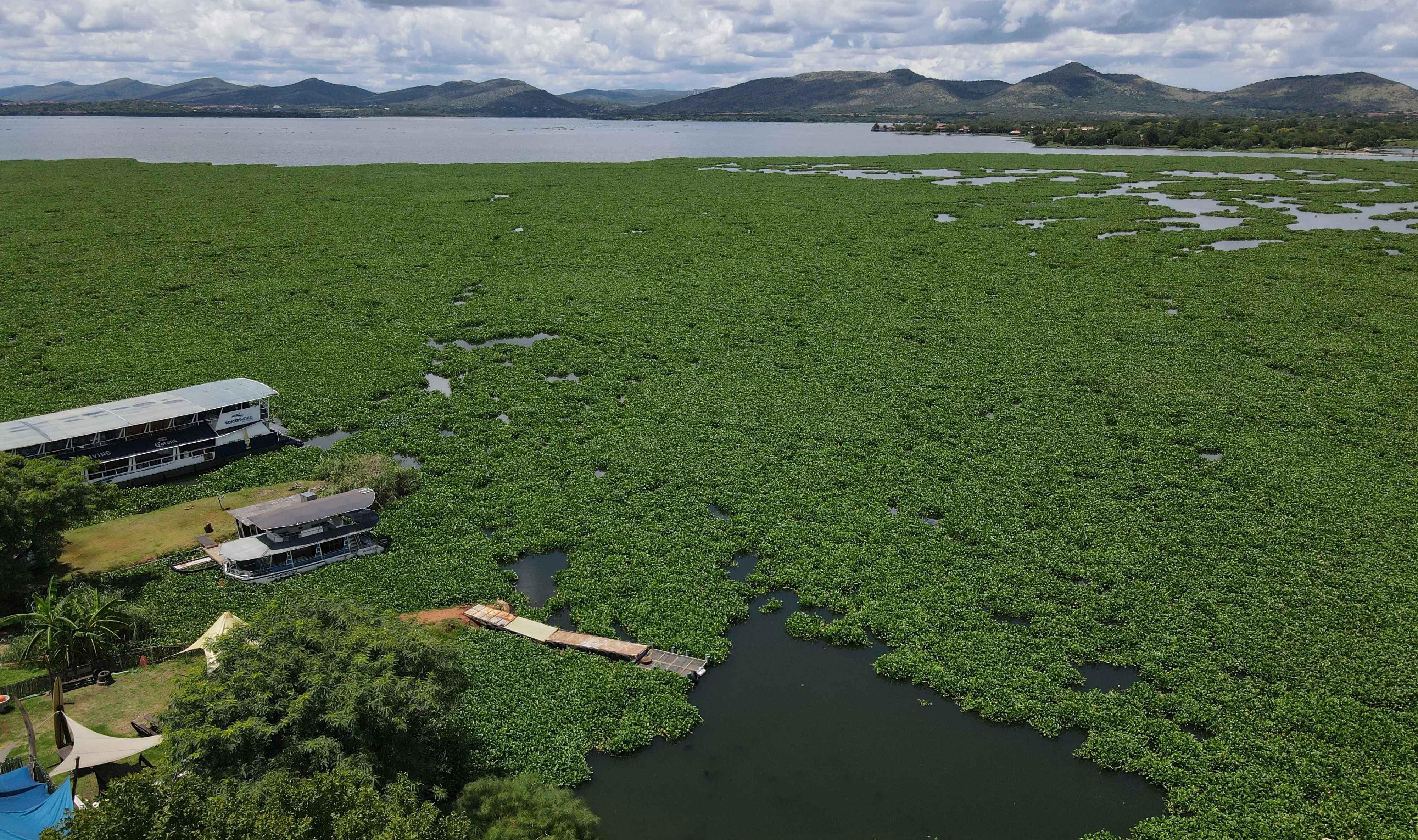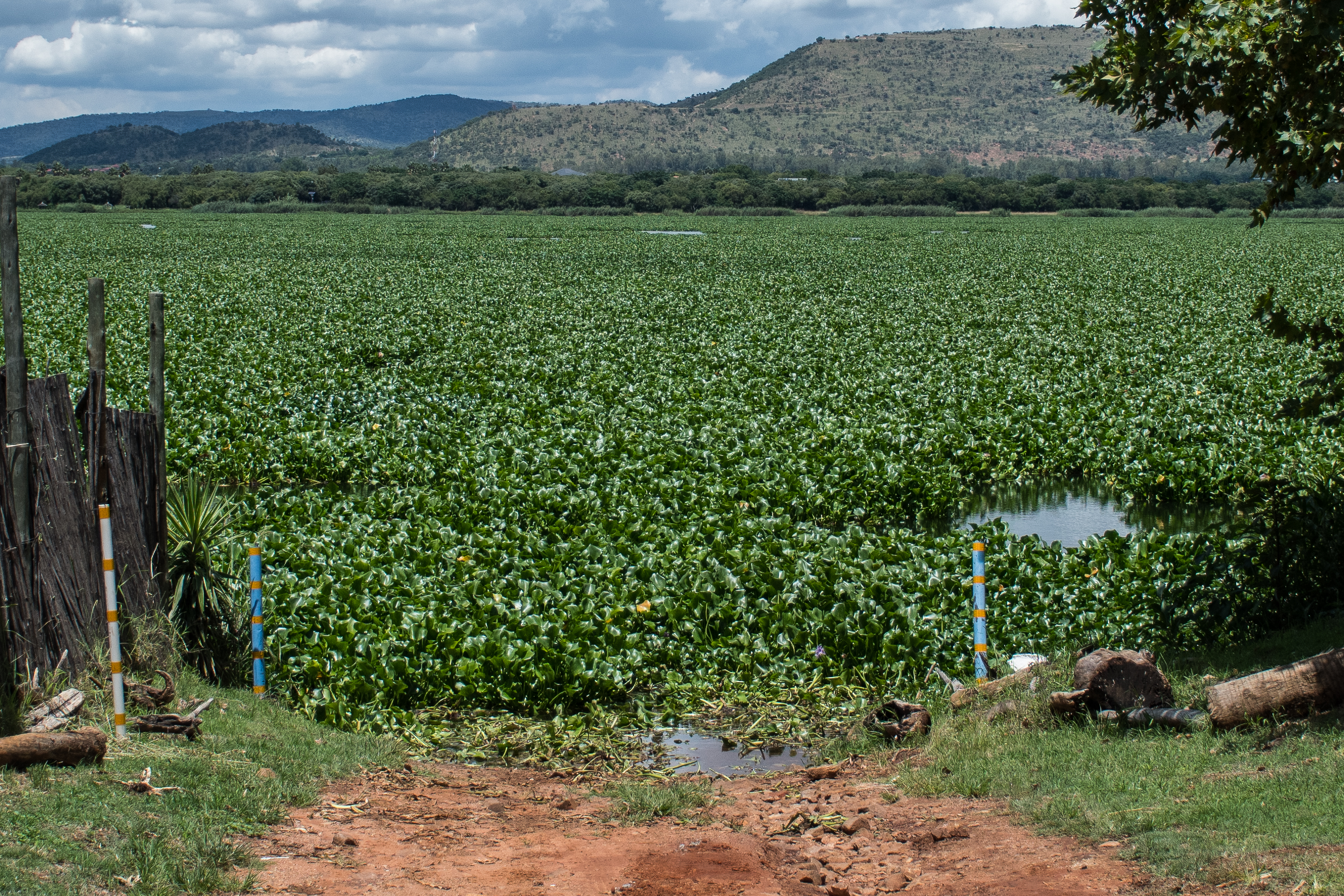INVASION FIGHTBACK
Hope for Hartbeespoort Dam water quality as new ‘nanobubble’ technology starts to bite

New technology being tested to clean up Hartbeespoort Dam has seen a ‘drastic improvement’ in water quality at the test site, and the impact is spreading.
Notorious for its hypertrophic waters, Hartbeespoort Dam is benefitting from an experimental project to clean it up.
The project, spearheaded by BluePlanet South Africa, is an effort to harvest and biocontrol invasive hyacinth through oxygen transfer technology.
Marcel Esterhuysen, operations director for BluePlanet SA told Daily Maverick that the company was selected after a request-for-information process by the Department of Water and Sanitation (DWS) and Magalies Water in 2023.
Read more in Daily Maverick: Rapidly worsening ecological condition of South Africa’s dams will likely eclipse rolling blackouts
David Magae, spokesperson for Magalies Water, told Daily Maverick that BluePlanet SA’s involvement at the dam was a research project and trial, not necessarily a fully implemented project.
“BluePlanet SA is expected to install and operate a nanobubble generator. They are also expected to train employees from Magalies Water and DWS on the operation of nanobubble technology,” said Magae.
The company’s website says that nanobubble technology collects water in the air, and, through a generator which requires 300 watts to power, converts the oxygen into ozone which decomposes organic matter and odours, killing pathogenic bacteria.

More than half of Hartbeespoort Dam has been covered with hyacinth since the beginning of 2023. (Photo: Ethan van Diemen)
The method also increases dissolved oxygen in the water, activating the decomposition of microorganisms in water or river sediment.
Over a month, the combination of the nanobubbles and water flow react to break down pollutants such as E.coli bacteria and total coliforms, increasing water transparency.
Mogae said that “the water quality in the pilot site has improved drastically and the impact is extending to the entire dam. There is a notable increase in oxidation-reduction potential (the measure of a water body’s ability to cleanse itself) and dissolved oxygen, accompanied by a drastic reduction in nutrients and an improvement in water quality.”
Read more in Daily Maverick: Rapid water lettuce spread threatens Vaal River — weevils could be the solution
But John Wesson, regional chair of the Wildlife and Environment Society of SA, told Daily Maverick that a part of the community had concerns about the use of the technology without it having proof-of-concept on a large body of water like Hartbeespoort, which covers over 2,000 hectares. The method is usually deployed on smaller bodies of water.
Read more in Daily Maverick: Harties vs the hyacinth (Part 3) – R24-million in funding left unspent as invasive weed overgrowth worsens
“Hartbeespoort can’t afford to experiment. When we look at the livelihood of the people at the dam, such as tourism, relying on an experiment will take about three years to show results and that won’t work.
“That means the community is going to invest in potential results and if it doesn’t work, the dam will still be in a bad state,” said Wesson.
He also raised questions about the amount of electricity the generator would require and the cost of that to the community. He said there were concerns about the technology increasing oxygen levels that act as a flocculant, causing sediment to settle at the bottom of the dam, thus adding to nutrient density.
Currently, 8% of the dam is covered in hyacinth.

The Hartbeespoort Dam was more than 60% covered in hyacinth from the beginning of 2023. (Photo: Julia Evans)
Wesson suspects that, given the manner in which the plants are dying, the decrease is a result of chemical spraying.
Esterhuysen maintained that in the short period of time the trial had been underway — it began at the end of January 2024 — there had been encouraging signs in the area where the generator had been placed.
The project is expected to run for a year.
Esterhuysen said he was unable to share specifics of the data due to a non-disclosure agreement between the company and Magalies Water. The entity would also not divulge how much money was being spent on the trial.
Read more in Daily Maverick: Harties vs the hyacinth (Part 2) – Rampant growth of the weed is choking everything in its path, including businesses
Magae said: “The plan is mature and fully crystalised, and it is yielding the desired outcome. The intervention enacted by Magalies Water is unique, novel and one of a kind.
“This turnaround strategy has improved the water quality of the Hartbeespoort Dam and reduced the dam coverage by floating plants. This is an impressive milestone.
“However, the premier quest is to curb nutrients loading at source using a myriad of proven and tested technologies for nutrients attenuation and water amelioration.” DM




















I can’t help to wonder – are there not other solutions to hyasinth problems that we have not thought about? What about harvesting it (ie removing them en masse) drying it and then using it to generate electricity or something like that? Or can it not be used for food, if not for mankind, then maybe for animals; if this is possible, we can then start to export it? I see on CNN an advertisement of an electricity generating waste burning plant in Sweden that generates enough electricity to power 170000 households (it is the advert where on top of the plant there is a grass lawn where people can slide off with the help of ski’s!). Just think of the possibility that all the communities around Hartbeespoort dam can be powered by hyasinth burning electricity, relieving some more pressure off Eskom; so we then, in the process, kills two flies with one swat.
Sadly Roelf this is another F Up by the cadres that “run” things, I use quotation marks because they run F’all unless they have a trough!
Some years ago, a group of residents got together and started harvesting the hyacinth, then used machinery to chop it up and sold it as (apparently very good) fertilizer. I suspect that because there was no trough provided for the cadres, they were forced to stop because they did not have a license… Go figure?? And in the interim the dam reverted back to the disgusting state we see now. I believe it is the equipment shown in the first picture above.
300 watts seems extraordinary little power? It must be a very small experiment – measured in buckets rather than dams.
Yeah – I think that was a mistake. The linked article says 1300W
The Agriculture Research Communication Centre journal of India claims that there are multiple uses for hyacinth, including feed for cattle, pigs and poultry. It can also be used as both compost, mulch and manure (one would think it would be ideal for the hot dry northern parts of the country close to the Harties dam, and others) along with other uses. These include basket weaving style items, a substitute for paper and other uses too. There’s a plethora of entrepreneurial opportunities to people who are able to think outside the box. Given how much hyacinth there is in our water systems nationwide, it could present a large-scale employment opportunity.
Many points here make me sceptical.
“unable to share specifics of the data due to a non-disclosure”: Is this a paid trial? Who profits or will profit from this “undisclosed data”?
“The entity would also not divulge how much money was being spent”: Money spending by the Department of Water and Sanitation (DWS) should comply with PFMA, therefore tenders or contracts like these should be transparent?
There are a few technical points that seems problematic, but the main one is the use of ozone. (besides the amount of energy required to generate ozone)
“killing pathogenic bacteria “: Ozone will kill and/or damage micro-organisms indiscriminately, the “good” and the “bad”. (as well as larger ogranisms) The dam is an ecosystem and not a sterile water reservoir. The first study I found relating to the use of nanobubble+ ozone in aquaculture shows a potential damage to fish gills.
Nanobubble technology is an aeration technology that has shown some promise in treatment of eutrophic water, but the use of ozone is concerning.
There have been talks about Weevils (biocontrol); at which point is it?
Well spotted.
I’ve found an on site picture of the actual bubble generator housing on the internet. Can’t post the link but it’s easy to find. The rather large diameter inlet and outlet pipes are also visible, with all the machinery housed in a garage sized container.
Small scale considering the size of the dam, but not that small, not 300Watt! Would be interesting to know the actual number that was meant there.
The process of bubbling air or oxygen into polluted water is well established and is used all over the world. Production of ozonized air as a disinfectant is also well proven. The only new thing about this process is the production of very small bubbles.
The technology website does NOT say it collects WATER from the air. Bad reporting.
As stated in the article “However, the premier quest is to curb nutrients loading at source using a myriad of proven and tested technologies for nutrients attenuation and water amelioration”
It should also be noted that this technology will improve water quality, thus slowing the growth of plants. It will not do anything to remove what is already there.
DM, your reporting is in need of improvement.
Note that the 300 watts seems to be a typo – the original article (translated by a web browser) says the machines use 1300 watts:
“ According to him, this equipment is difficult to install in upstream areas without sufficient access to electricity because it requires around 1,300 watts for each unit for the generator.”
Ho hum, while ozone in the upper atmosphere (the famous ozone layer) protects the earth from radiation, in the lower atmosphere it acts as a greenhouse gas.
Too much of it is deadly for humans and other air breathing creatures too — it attacks the nose and throat.
As others have said, mechanically getting rid of the plant and using it as compost or mulch makes much more sense, and is probably cheaper too.
If you continually cut down plants, eventually, even the most persistant die.
The only problem is finding workers without parasitic gangsters, sorry “union leaders” popping up and demanding exorbitant sums before work can start — something which anecdotally is now happening all over SA and not just in Durban and Joburg.